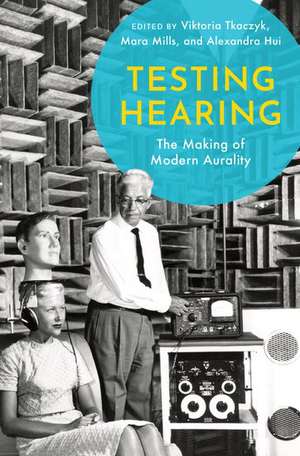Testing Hearing: The Making of Modern Aurality
Editat de Viktoria Tkaczyk, Mara Mills, Alexandra Huien Limba Engleză Paperback – 22 oct 2020
| Toate formatele și edițiile | Preț | Express |
|---|---|---|
| Paperback (1) | 431.09 lei 3-5 săpt. | |
| Oxford University Press – 22 oct 2020 | 431.09 lei 3-5 săpt. | |
| Hardback (1) | 704.14 lei 31-37 zile | |
| Oxford University Press – 22 oct 2020 | 704.14 lei 31-37 zile |
Preț: 431.09 lei
Nou
Puncte Express: 647
Preț estimativ în valută:
82.50€ • 84.49$ • 68.63£
82.50€ • 84.49$ • 68.63£
Carte disponibilă
Livrare economică 26 februarie-12 martie
Preluare comenzi: 021 569.72.76
Specificații
ISBN-13: 9780197511138
ISBN-10: 0197511139
Pagini: 416
Ilustrații: 30 illustrations
Dimensiuni: 236 x 160 x 23 mm
Greutate: 0.45 kg
Editura: Oxford University Press
Colecția OUP USA
Locul publicării:New York, United States
ISBN-10: 0197511139
Pagini: 416
Ilustrații: 30 illustrations
Dimensiuni: 236 x 160 x 23 mm
Greutate: 0.45 kg
Editura: Oxford University Press
Colecția OUP USA
Locul publicării:New York, United States
Recenzii
[Testing Hearings] narratives are so convincing and insightful because they are rooted in long-standing interdisciplinarytraditions ofresearch in studies of science and technology, urban studies, music an musicology, and because they draw on rigorous research in archives that have been maderelevant through a focus on sound and hearing. The authors are able to ask new questions about sound and hearing because they can comfortably navigate claims and approaches at the intersections of fields of which they have intimate knowledge.
This book shows that testing has long been critically embedded at the level of infrastructures...The second major intervention of this volume is its attention to the epistemic value of the aural to scientific practice. By bringing sound studies into conversation with history of science, this collection provides a new framework for analyzing the "co-creation of modern epistemic and auditory cultures" (p. 2). This broad framework aligns with a global focus, and this breadth reveals how science happens outside of traditional testing arenas. Testing hearing takes place not in laboratories but in laundromats, on streets, in submarines, studios, stages, and societies.
Highly Recommended.
That hearing norms are 'built into all manner of audio apparatus, from telephones to stereo speakers' is one of many insights in this intriguing interdisciplinary collection. Historians, having too long focused on technology's visual aspects, can surely benefit from understanding the configurational ramifications of the aural too. Testing Hearing helpfully turns our attention to consider how the power relations of listening and hearing are mediated by technologies ... the historicist volume reviewed here breaks new ground in focusing on the epistemic and politically charged issues of testing hearing.
Comprehensive, multifaceted and absorbing, Testing Hearing is a major achievement, destined to become a classic of sound studies and beyond.
Testing Hearing explores 'the co-creation of epistemic and auditory cultures-indeed, the creation of modern aurality'...Testing Hearing has a thematic architecture, with sections focusing on the history of tests that screened human hearers 'out' and 'in'...Testing Hearing is also exemplary in its involvement of two experts in testing in the sciences, Hans-Jörg Rheinberger and Trevor Pinch, who offer supplementary commentaries on the collection' chapters from, respectively, the perspective of the history of science and that of science and technology studies (STS).
This book shows that testing has long been critically embedded at the level of infrastructures...The second major intervention of this volume is its attention to the epistemic value of the aural to scientific practice. By bringing sound studies into conversation with history of science, this collection provides a new framework for analyzing the "co-creation of modern epistemic and auditory cultures" (p. 2). This broad framework aligns with a global focus, and this breadth reveals how science happens outside of traditional testing arenas. Testing hearing takes place not in laboratories but in laundromats, on streets, in submarines, studios, stages, and societies.
Highly Recommended.
That hearing norms are 'built into all manner of audio apparatus, from telephones to stereo speakers' is one of many insights in this intriguing interdisciplinary collection. Historians, having too long focused on technology's visual aspects, can surely benefit from understanding the configurational ramifications of the aural too. Testing Hearing helpfully turns our attention to consider how the power relations of listening and hearing are mediated by technologies ... the historicist volume reviewed here breaks new ground in focusing on the epistemic and politically charged issues of testing hearing.
Comprehensive, multifaceted and absorbing, Testing Hearing is a major achievement, destined to become a classic of sound studies and beyond.
Testing Hearing explores 'the co-creation of epistemic and auditory cultures-indeed, the creation of modern aurality'...Testing Hearing has a thematic architecture, with sections focusing on the history of tests that screened human hearers 'out' and 'in'...Testing Hearing is also exemplary in its involvement of two experts in testing in the sciences, Hans-Jörg Rheinberger and Trevor Pinch, who offer supplementary commentaries on the collection' chapters from, respectively, the perspective of the history of science and that of science and technology studies (STS).
Notă biografică
Viktoria Tkaczyk is Professor of Media and Knowledge Technologies at Humboldt University in Berlin.Mara Mills is Associate Professor of Media, Culture, and Communication at New York University who works at the intersection of disability studies and media studies. Alexandra Hui is Associate Professor of History at Mississippi State University and Co-Editor of the journal Isis.
